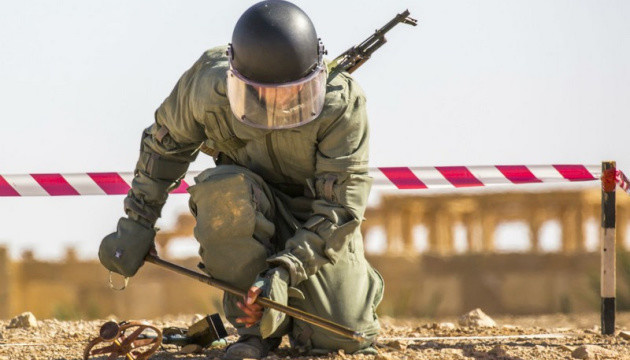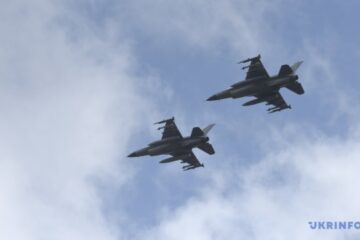Ukraine has accumulated UAH 2.5 billion for this year’s mine action campaign, but more funding needs to be found, including through investment programs.
Last year, Ukraine cleared more than 35,000 square kilometers of landmines and explosive remnants of war (ERW), and returned it to production, with farmland given priority for clearance. That being said, after the first year of the full-scale Russian invasion, there were at least 174,000 square kilometers of potentially contaminated land in the country. The World Bank estimates that this will cost at least $367 billion to survey and clean it up. It goes without saying that this amount has only grown ever since. With that taken into account, in order to achieve the ambitious goal of returning at least 80 percent of potentially contaminated land to economic production within the next ten years, survey and demining work must be carried out continuously, despite the war ongoing. What has already been done and what needs to be done to give more momentum to the mine clearance effort in Ukraine?
FARMLAND CLEARANCE: PLUS 1,000 HECTARES FOR THE FUTURE HARVEST
Summing up the results of last year’s activities by government agencies — the State Emergency Service, the Special Transport Service, the National Police, the National Guard and the State Border Guard Service, which all have mine action divisions within their structure — and commercial mine action operators, Deputy Minister of Economy Ihor Bezkaravayny said at a briefing at the Media Center Ukraine that survey and demining operations can only be conducted in areas located at least 20 kilometers from the front line. The worst contaminated locations — territories where hostilities are still ongoing, areas of continuous mining zones, water bodies, natural lands, and built-up areas — will not be demined until after the war comes to an end.
“This spring, we crossed the mark of 1,000 hectares of agricultural land demined, cleaned up, and released to farmers for productive use, within the framework of the government-funded programs that reimburse farmers for the cost of demining their fields. These fields can already be sown, and harvested in the fall,” said Bezkaravayny.

In March, for example, the 434-hectare land plot owned by the Potato Farming Institute under Ukraine’s National Academy of Sciences, where artillery shells and landmines were discovered and removed, was declared free of mine contamination, according to Yulia Svyrydenko, senior vice Prime Minister and Minister of Economy of Ukraine.
“Just six months ago, even 1,000 hectares of demined land sounded too ambitious. Today, this is already a reality. These are the fields that are being sown with wheat and other crops right now. This is the future harvest, instead of the hazardous remnants of war. The government has not only verbally declared its interest in demining farmland, but has also created a tool that allows us to make Ukrainian land safe again, meter by meter,” Svyrydenko said.
As reported, the government’s program to compensate farmers for the costs associated with demining farmland has been active since March 2024. The Ukrainian government started to implement this program in May 2024, reimbursing farmers for 80 percent of demining costs incurred from February 24, 2022, to April 15, 2024. The prerequisites for applying, however, mandated that the farmer held no tax debt and that their land had been confirmed as contaminated by a nontechnical survey conducted by a certified mine action operator. This program was expanded just months later in September to compensate farmers for 100 percent of demining costs and opened coverage to farmers with tax debt.
In line with the compensation program’s expansion, Ukraine launched an open auction for demining services in the government’s Prozorro system through which farmers can procure contracts for services priced by bidding operators depending on the density and complexity of contamination.
Auctions have already been held to procure demining services under 56 applications to demine 11,000 hectares. Work is ongoing under 40 concluded agreements on demining an acreage of approximately 9.500 hectares. The terms of seven agreements with a total value of UAH 52 million have been completely fulfilled, with 1,102.9 hectares already returned to productive use. These are three land plots in the Mykolaiv region (131.4 hectares), two in the Kyiv region (921.9 hectares), as well as land plots in the Kherson (21.1 hectares) and Kharkiv (28.5 hectares) regions.
Commenting on the demining cost reimbursement program, Ihor Bezkaravayny emphasized that any farmer who works legally, pays taxes regularly and has no ties to Russia can apply for participation. Applications for demining soils affected by the war are accepted through the State Agrarian Register.
“After that, the land plot is surveyed to confirm it is contaminated, and the approximate cost of demining is determined, and this “lot” is posted on Prozorro. Mine action operators – private companies (mostly Ukrainian) – can compete for contract awards. The money provided under the program is stored in a special escrow bank account, which is inaccessible to either the agrarian – the owner of the land, or the winner of the auction with whom the contract for the work was concluded,” the official explained the mechanism for financing the program. And only after the demining work is completed, inspected and quality certified, confirming that the land plot is safe, the money is transferred from that account to the mine action operator’s bank account.
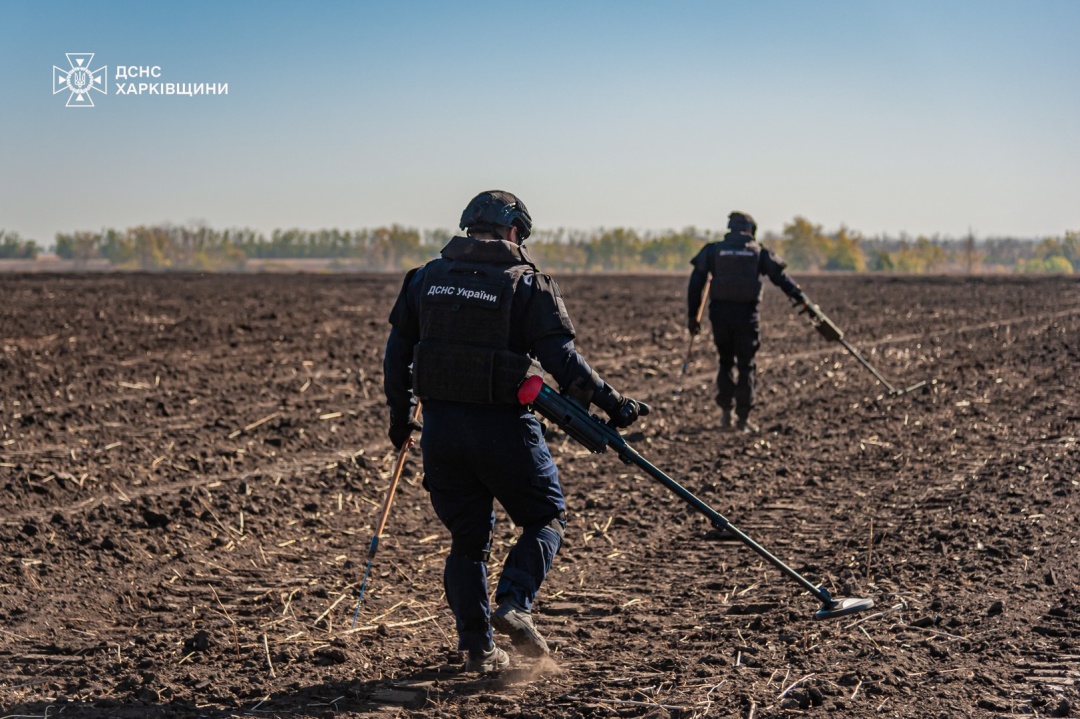
Photo: State Emergency Service for Kharkiv Oblast
Farmers are not all aware of this program and understand the algorithm of its operation, Bezkaravayny continues to note. For that reason, there have been lots of applications filed to the Agrarian Register that were not supposed to be filed.
“The vast majority of the work done is spent on verification of the applications submitted, which, in fact, stalled implementation of the program. Therefore, we are now improving the program so that there are fewer erroneous applications. We are also preparing a large-scale information and awareness campaign, educational materials, because the demand for such services is huge,” the official said, adding that a total of UAH 2.5 billion was allocated for demining programs for 2025. The effective use of these funds is one of the benchmarks set by the European Union’s Ukraine Facility financial assistance program for Ukraine.
MONEY FOR DEMINING: DONOR ASSISTANCE AND CO-FINANCING
In humanitarian demining, as in any other industry, the search for financial resources is one of the most acute challenges. Here, for the time being, we can count mainly on grant support from international partners, which the government directs both to the implementation of the aforementioned compensation program for demining agricultural land as well as other programs being implemented by the State Emergency Service, the State Service for the Protection of Natural Resources and the Environment, and other specialized entities.
For almost a year now, humanitarian demining in Ukraine has been carried out as part of the Cabinet-enacted National Mine Action Strategy 2033 and its Implementation Plan 2024–2026. The adoption of the Strategy is one of the benchmarks set by the Ukraine Facility, the European Union’s program of financial assistance for Ukraine.
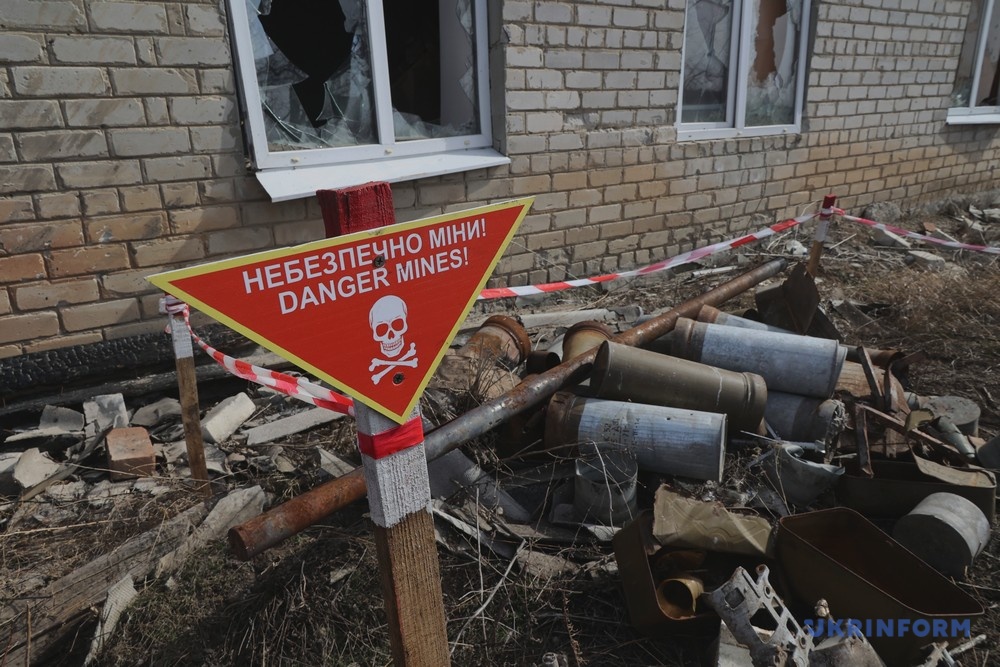
Further to this, foreign countries are initiating their own programs to support humanitarian demining programs in Ukraine. For example, the Italian Agency for Development Cooperation (AICS) recently announced a grant competition for the clearance of Ukrainian lands from land mines and ERW in frontline areas, with a total budget of €6 million. Projects aimed at nontechnical and/or technical survey of territories will be financed, along with a public awareness campaign to inform the population about landmine and ERW hazards. This initiative prioritizes demining of contaminated areas in the Kharkiv region, where 55 out of the 56 currently existing communities have been affected by the war. The Kharkiv region has become a pilot for the automated prioritization of territories based on IT solutions provided by Palantir company.
“This is the first time that one of our partner countries is directly allocating funds for demining our lands, engaging Ukrainian demining operators in the process. I believe this cooperation will help accelerate the return of land to safe use, identify contaminated areas and strengthen collaboration not only at the institutional level but also between organisations and companies from other countries that seek to make Ukrainian land safer,” said Yuliya Svyrydenko.
Only non-profit organisations are eligible to apply for the competition, though they may partner with commercial demining operators for project implementation. Individual projects can receive up to €1.8 million in financing.
Meanwhile, the Cabinet of Ministers has allowed the funds collected on the Ministry of Economy’s bank account through the UNITED24 fundraising platform to be used to pay for humanitarian demining services.
“The endorsed amendments will, above all else, allow us to launch targeted fundraising campaigns through the UNITED24 platform to demine communities. We give our friends and partners the opportunity to choose what they want to prioritize for funding: the purchase of demining machines, equipment, or to allocate money for the Humanitarian Demining Center to pay for demining services,” commented Ihor Bezkaravayny.
This enables the Humanitarian Demining Center, whenever necessary, to request the Ministry of Economy to allocate funds raised through UNITED24. The fund balance amounted to UAH 53 million as at the beginning of the year.

Overall, approximately UAH 200 million was raised through the UNITED24 fundraising platform so far. The fund paid to procure a heavy pyrotechnic machine, three light pyrotechnic machines, plus two tractors for the State Emergency Service. The State Special Transport Service procured Trembita metal detectors, 400 protective visors and aprons, and a heavy DOK-ING MV-10 demining machine purchased through co-financing.
That said, however, this money will definitely not suffice now or after the war ends, considering the enormous requirement of tens of billions of dollars. Ukraine therefore has to borrow and invent new technologies, apply innovative approaches to surveying territories, mechanize demining operations to the maximum degree possible, and also set up a system of incentives for soliciting mine action operators from all over the world, including through market-based approaches, without being confined to international humanitarian missions only, experts say.
And, of course, it is necessary to use, to the maximum extent possible, financial resources provided by the State budget and by specialized government institutions engaged in surveying and demining landmine and ERW contaminated territories. Because the current commercial prices for these services, considering the acreage of contaminated land, are clearly unaffordable for Ukraine alone. For, as you may know, the cost of demining amounts to $3–5 per square meter, up to $50,000 per hectare, and up to $5 million per square kilometer. This amount is unaffordable even for a major agricultural holding, let alone an individual farmer.
This makes the Ministry of Economy work intensively with international financial organizations, such as the World Bank, the European Bank for Reconstruction and Development, the European Investment Bank and other institutions to raise meaningful investment in mine action and humanitarian demining programs in Ukraine.
“Before the great war, mine action operations in Ukraine had not been perceived as attractive for investors. “These were always donors who simply went to solve some specific problem. Now we are trying to shift the focus of attention, explaining to potential investors: if, for example, you invest money in demining a field, and then apply sustainable agricultural practices and grow some ecological produce within the framework of the “green transition”, it can be much more expensive than conventional agriculture, and so, in theory, one can make money from this, too,” says Bezkaravayny.
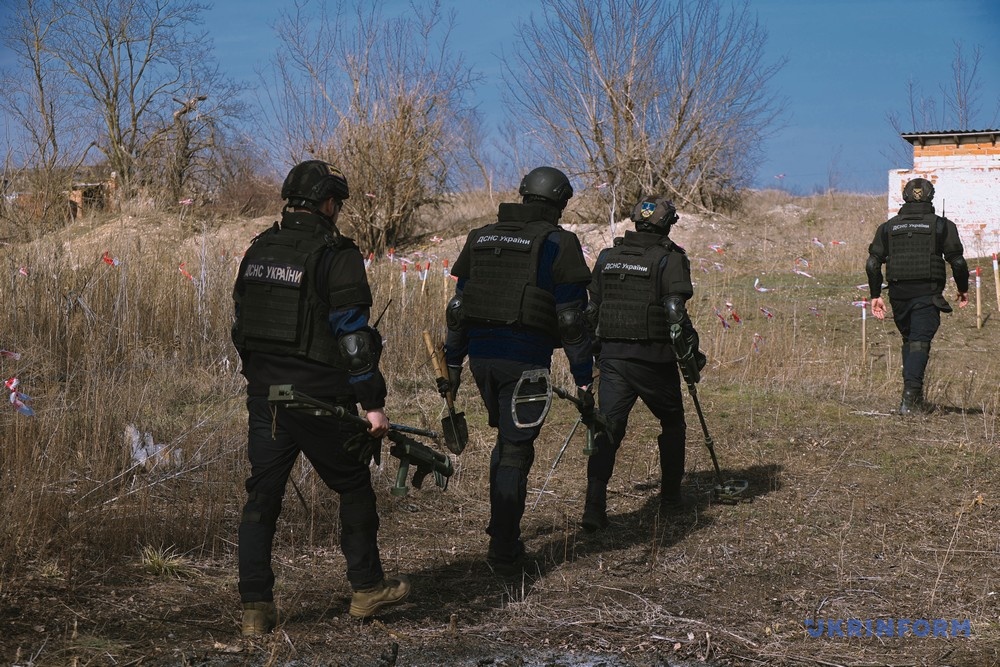
Photo: Mechanical demining machine Digger / via Swiss government website
At the same time, he continues to note, the talk is also about the possibilities for attracting loans, about bank guarantees, risk insurance, and for using other financial instruments.
The search for resources for demining forest lands is also among the near-term “financial” tasks to be tackled, according to the deputy Economy Minister.
“Forests will not be the last to be cleared of mines, as some may believe. They will be demined immediately after we find additional resources and direct them to the forestry sector. Why can’t forests be last in line? There are several reasons, forest fires being the first one. If the forest is contaminated, the roads are mined, and a forest fire gets ablaze, there is zero chance of it being extinguished, as fire crews will simply blow themselves up on mined roads before they will be able to reach the site of fire,” the official explained.
HUMANITARIAN DEMINING SERVICES MARKET AND OPERATORS’ TECHNOLOGICAL EQUIPMENT
At the beginning of 2023, zero mechanical demining machines were in use across Ukraine, only six mine clearance operators were certified, and just 1,500 sappers (or persons certified to conduct demining operations) were active. As of October 2024, 98 mechanical demining machines are at work, 58 operators have been certified with an additional 57 operators in the process of obtaining certifications, and 4,300 sappers are active, according to statistics from the Economy Ministry.
Seven of the world’s top biggest mine action companies have their operations in Ukraine.
Due to support from international partners and the presence of numerous foreign mine action operators in Ukraine, the fleet of specialized demining equipment, including heavy demining machines, has expanded significantly compared to the first year of the great war. Furthermore, for the first time in world practice, drones and robotic systems are being used in demining operations of that extent and scale.
“At the beginning of 2023, there was not a single heavy demining vehicle in the country. Now there are over 150 of them operating in Ukraine. Back then, there were only six mine action operators and 1,500 sappers,” Yulia Svyrydenko noted as a remainder.
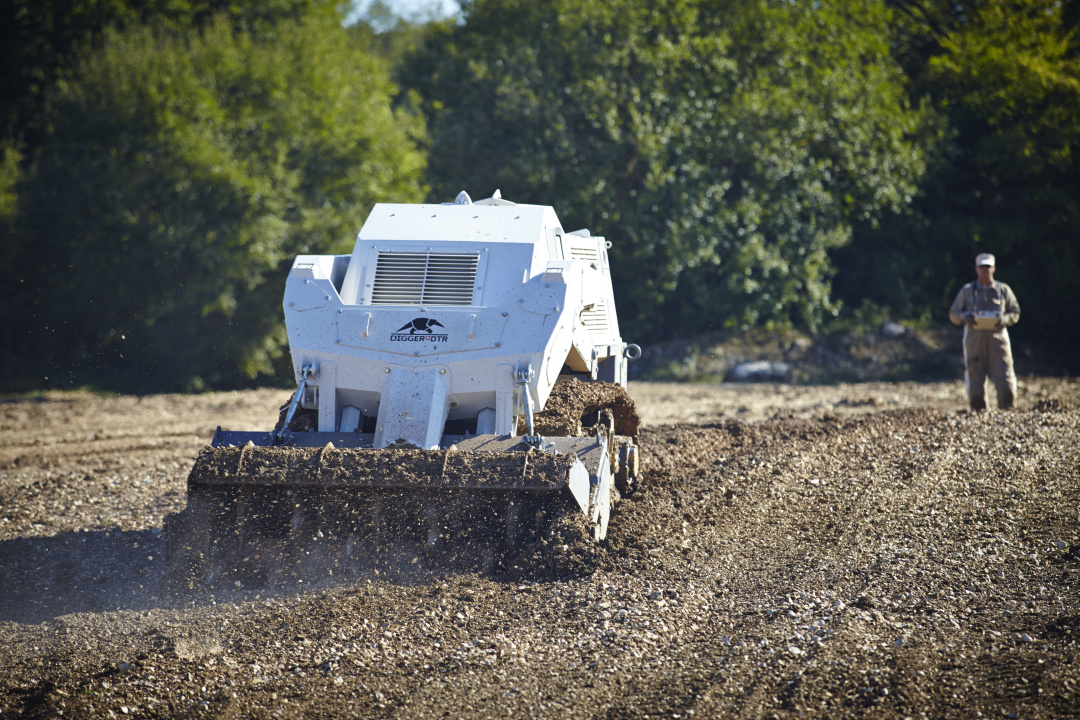
Digger demining machine / Photo from the Swiss government website
She says that the focus is on the domestic production of demining machinery and equipment in Ukraine. As an example, the government official cited cooperation with the Croatian company DOK-ING, which has already launched its representative office in Ukraine. The government has endorsed a procedure for certifying mechanical demining machines according to international standards. The first DOK-ING machine has been certified according to the MV-4 standard.
There are machines that have been fully designed and developed domestically in Ukraine. For example, the Kramatorsk Heavy Machine Tool Plant has developed and built remotely controlled demining system named Germina URCM-3000. The machine is capable of demining up to 5 hectares of contaminated land every day and can withstand the detonation of an anti-tank mine. A mine action operator is currently using the first operational prototype in experimental mode. After that, the machine will be sent for certification of conformity.
“Such a machine is a good example of using the manufacturer’s technical capabilities, taking into account the experience of Ukrainian sappers. I hope that Germina will successfully pass certification and that we will receive a Ukrainian demining machine with excellent characteristics and performance parameters. More than 60% of its components are Ukrainian-made,” according to Bezkaravayny.
With its working mechanism submerged 5 centimeters into the soil, the machine covered a 100-meter distance in just 90 seconds.
The passage’s width was 2.7 meters. This allowed for surface clearance of a one-hectare area in an hour and five hectares in one shift.
During the demonstration tests, Germina was able to destroy all the training mock-ups of explosive objects laid out on the site, including anti-tank mines TM62 and PTM4; anti-personnel high-explosive mines; as well as hand grenades. The machine used the engine, chassis, and hydraulics of the best European and American brands. It can be remotely controlled from up to one kilometer away.
The manufacturer claims that its new machine, priced at approximately 500,000 euros in the basic fit, will be several times cheaper than foreign equivalents.
In the year’s first half, the mine action operator UDS is looking to acquire five Germina machines from the Kramatorsk Heavy Machine Tool Plant to perform humanitarian demining tasks in the Kyiv, Kharkiv, Mykolaiv, and Kherson regions.
The government’s “Made in Ukraine” economic policy has identified demining—including the domestic production of demining machinery and equipment—as an industry that can support Ukraine’s reconstruction and economic recovery. There are 19 manufacturers in Ukraine that produce a lot of equipment needed for demining: ranging from protective gear and ordinary tools used in the field, to high-tech products, detectors and large, heavy machines. This all is manufactured domestically in Ukraine and must be procured from Ukraine,” Ihor Bezkaravayny emphasized.
Vladyslav Obukh, Kyiv
Headline photo via armyinform.com.ua
Source: Humanitarian demining: challenges and priorities for 2025

